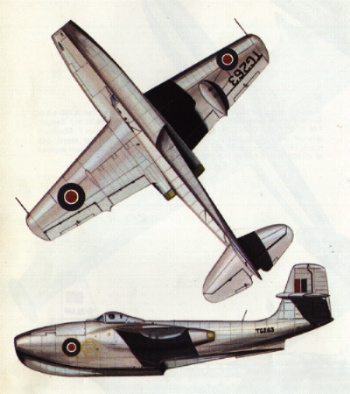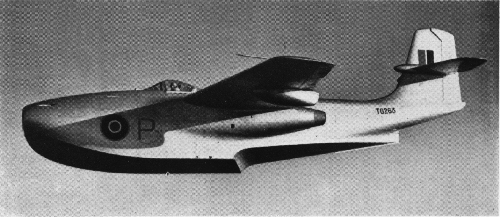

When Japan surrendered in 1945, military aircraft development did not end with quite the abruptness that it did so after the signing of the Armistice in 1918. This was due partly to governmental plans for a more orderly transition to peace, and partly to the fact that, although a great war against evil had just ended, the world was not necessarily a peaceful or safer one. The Russian blockade of Berlin in 1948 demonstrated this sad fact and was the harbinger of events to come. Thus, in spite of the increasing comparable superiority of land based aircraft, funds continued to be allocated to the continued development of marine aircraft, in Britain and the U.S.A., and to a lesser degree, Russia.
During the war the development of and the potential uses of the jet engine, were not unnoticed either by the designers of flying boats or by their service users. The war in the Pacific had demonstrated the need for air superiority during the vital landing periods as Allied troops laboriously retook the islands in that ocean overwhelmed by the Japanese during their campaigns of 1942. The need for a fighter was apparent and the idea was conceived for one which could be deployed when no airfield was available.
Thus in 1944 Britain issued a specification for a single-seat, twin-jet fighter flying boat for use in such areas. Four years previously the Japanese Navy had issued a specification for a single seat fighter seaplane to cover the early phases of amphibious landings and for the defence of small islands where hard runways were impractical! The result of this specification was a float-plane development of the exceptional 'Zero' fighter, the appearance of which was one of the more unpleasant shocks given to the Allies during the initial stages of the war in the Pacific.
In the British specification the application of the jet engine to a marine aircraft held promise of eliminating some of the inherent features of seaplanes which placed them at a disadvantage when compared with high performance land based aircraft. These were, principally, the high thrust line required by propellers, the poor aerodynamic shape for high speeds of a hull which had adequate water performance, and the relatively high structure weight of a hull compared with a land based fuselage.
| Designed at Cowes, Isle of Wight,
by a team under the leadership of Henry Knowler,
the single-seat SR/A1 was the world's first
jet-powered flying boat to fly. It had come into
being as a result of Air Ministry Specification
E.6/44, a wartime requirement for a high-speed
fighter capable of operating from coastal waters
in the Pacific theatre. Outwardly conventional in
its appearance, the SR/A1 nevertheless embodied a
number of features designed to result in an
aerodynamically clean exterior with the minimum
of drag-producing protrusions. The new fighter was designed around two Metropolitan-Vickers Beryl turbojets. These engines, the first British axial-flow engines, developed up to 1,746 kg (3,850 lb.) thrust, and were small in diameter compared with the centrifugal type favoured by other aircraft manufacturers at that time. |
 |
Two, therefore, could be installed side-by-side without making the beam of the hull unduly great. The intake was provided with an extendable lip which was intended to overcome water ingestion troubles, although this in fact was not needed. The engine exhausts exited at the trailing edge of the wing root and were splayed out 5 degrees each side of the centre line.
Stabilising floats were mounted at approximately two-thirds span. These could be retracted inwards after take-off, the floats themselves rotating an additional 90° during the process so that the curved upper surface was outermost in the fully-retracted position. The pilot's compartment was built as a complete unit, fitted with a Martin-Baker ejection seat, and provision was made for the installation of four 20 mm Hispano Mk 5 cannon in the upper front portion of the hull, firing through ports above the nose intake to eliminate any harmonisation difficulties. In addition, either two 450 kg (1,000 lb.) bombs or eight rockets could be carried. Internal fuel capacity could be increased by more than 60 per cent by the use of flush-fitting, jettisonable slipper tanks beneath the inboard wing panels.
Because of the leisurely pace of the development programme, it was not until June 1947 that the SR/A1 flew, when its graceful hull of faired Vee form was displayed to advantage for the first time. With a top speed of over 500 mph, its performance approached, but did not quite equal, contemporary land based fighters such as the Meteor and Vampire.
 |
This was amply proved during the 1948 Farnborough Show when the Saunders Roe test pilot, Geoffrey Tyson, gave a superb display of aerobatics including some really spectacular low inverted flying that no one who saw it is ever likely to forget. |
Three prototypes of the SR/A1 were ordered (TG263, TG267 and TG271), and the first of these, piloted by Geoffrey Tyson, made its first flight at East Cowes on 15 July 1947.
In this aircraft the Beryl turbojet engines were restricted to an initial thrust rating of 3,250 lb.; the second prototype, which flew in 1948, was fitted with 3,500 lb. st MVB 2 engines, and in the third machine the F.2/4A Beryl Mk 1 reached its full design rating of 3,850 lb. st. During 1948 also, a reinforced cockpit canopy replaced the original fully transparent Perspex hood and a streamlined 'bullet' fairing was added at the tail plane/fin intersection to improve the airflow.
Although flight trials were generally satisfactory, and the aircraft highly manoeuvrable, two of the prototypes were later involved in accidents, though not before one of them had demonstrated its ability to fly at speeds more than 70 mph (113 km/hr) in excess of the then existing world speed record for seaplanes. One was lost when the pilot, practising for a local air display in bad weather, crashed into the sea. A second was lost when it struck a half-submerged baulk of timber just after touching down. The loss of the two aircraft, plus the fact that exports were unlikely, brought the SR/A1 programme to an end.
Tests were resumed with the third aircraft for a short period in November 1950, when the Korean War had indicated the usefulness of a fast, heavily-armed flying boat operating in support of naval and ground forces. This machine was last reported preserved by the Skyfame Museum at Staverton, Gloucestershire.
The SR/A1 represented a valiant attempt to harness jet propulsion to a marine aircraft. Although the aircraft performed well in isolation, it was still outclassed by contemporary land plane jet fighters and it was by no means a practical weapon system. The twin problems of refuelling and rearming quickly under operational conditions were never tackled satisfactorily.
Ref:
Flying Boats and Seaplanes - Kenneth Munson
Seaplanes and Flyingboats - Maurice Allward
25 Nov 98
